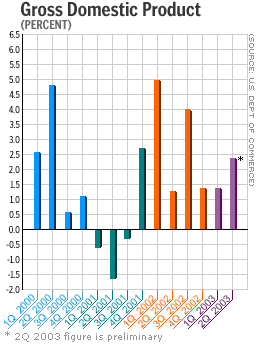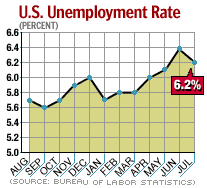NEW YORK (CNN/Money) -
U.S. economists are having an argument. While that might sound about as enthralling as watching paint dry, keep in mind that the future of the economy -- and your job -- is at stake.
After a relatively short, mild "recession" in 2001, as defined by the gurus at the National Bureau of Economic Research, there's been a long, slow "recovery," as defined by everybody but about nine million unemployed people.
The argument, simply put, is over what sort of recovery this really is.

One side says the economy's stubborn refusal to grow faster or to create jobs has simply been the result of abnormalities -- corporate scandals and war are the prime suspects -- that poked sticks in the wheels of a normal business-cycle expansion. Now that the weirdness is clearing up, businesses are getting more confident, and robust growth and jobs are on the way.
"I get the feeling that the economy was really wanting to move ahead more quickly last year, then hit a bunch of speed bumps," said James Glassman, senior economist at J.P. Morgan (not the James K. Glassman who wrote Dow 30,000). "I get the feeling companies are ready to start building their businesses and do lot of what normally happens in an expansion."
The other side says the economy has actually been suffering from the hangover of the late-1990s boom in economic growth, stock prices and corporate spending, and that there's still some post-bubble excess to clear out before the economy will be healthy again.
| Related stories
|

|
|
|
|
"Going forward, is there still adjustment in the pipeline? I think there is," said Goldman Sachs economist Jan Hatzius. "The household savings rate is low, and debt growth has accelerated. That means that consumer spending growth is going to be slow. In the next 12 months, the economy is going to do well, but it will be a temporary acceleration rather than the beginning of a normal recovery."
If the first side is right, then happy days are indeed here again, give or take a few months.
If the second side is right, then the economy could be in for a lot more of the stop-and-start action it's seen the past couple of years, and jobs could remain relatively scarce.
On the bright side
There's no question that businesses, the doubting Thomases of every economic recovery, are finally starting to feel the first smidgen of confidence.
"For the first time in a very long time, I believe external factors are slowly starting to be more positive," Cisco Systems (CSCO: Research, Estimates) CEO John Chambers said in a conference call Tuesday night, as he announced the company's latest quarterly earnings and outlook for sales growth in the current quarter.

Though Wall Street thought Cisco's revenue growth forecast wasn't quite bullish enough, it was the most optimistic view for the network gear maker in eight quarters.
Chambers said he saw strength in sales to small and mid-size businesses, which he believes is the first stage in a broader recovery among Cisco's customer base.
Small businesses could very well lead the rest of the economy out of the wilderness. They're often the first to start hiring workers in an expansion, and a recent survey by the National Federation of Independent Business showed small-business owners' optimism about the economy's future matched its highest level ever in June.
If the economy is in the middle of a normal business cycle, then more-confident companies will start expanding their operations at the first signs of the tax-cut-fueled consumer spending surge most economists expect in the second half of 2003. That expansion will include even great business spending and, probably, hiring.
"I think we are going to get consistent job growth," said Ken Goldstein, economist at the Conference Board, a private research group that keeps track of consumer confidence (it's stalled) and help-wanted advertisements (they're rising). "The signals we're getting suggest we're on the road to better growth. Unless something else happens, then perhaps in a few months, we will finally get some good news in the labor market."
On the dark side
But will that rebound in business spending and hiring last? Again, if the economy is in a normal cycle, then it should -- the increased activity and hiring will fuel more consumer spending, and a virtuous cycle of reinforcing warm fuzzies will make the economy ever healthier.
On the other hand, some economists worry that the increased business confidence won't translate into jobs soon enough to boost consumer confidence and spending, and businesses could put the brakes on a broader expansion if they see consumer demand fall.
What's more, with interest rates skyrocketing suddenly, the mortgage refinancing and housing-market boom that carried consumers through the past year or so is history, and consumers might suddenly realize they're in more debt than ever, with very little cushion of savings or home equity to protect them from financial disasters.
"This economy is too fragile to sustain this type of severe rate rise; the consumer sector is leveraged up the gourd," said former Federal Reserve economist Lacy Hunt, now chief economist at Hoisington Investment Management in Austin, Texas. "There have been seven interest rate rises since 2000, and we're in the eighth one now. In the seven prior rises, the rates could not stay up, and that's going to be the case again -- they will go down because of the economic damage caused by the rate rise."
If consumers pull in the reigns on their spending -- which makes up more than two-thirds of the total economy -- then all that business expansion will likely dry up, too, and the economy will be in for another bad spell.
"I'm not sure which form it will take -- maybe a lengthy period of subdued consumer spending or something more violent than that," said Hatzius of Goldman Sachs. "But it's clear to me that households cannot continue to save 3 percent of their disposable income and grow debt at 10 percent per year."

|

